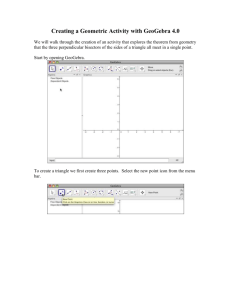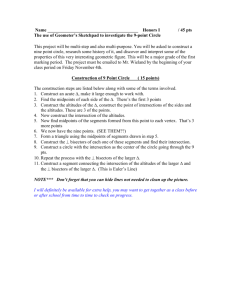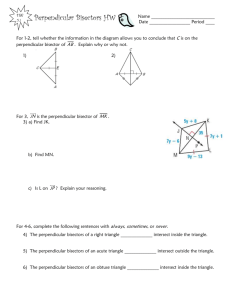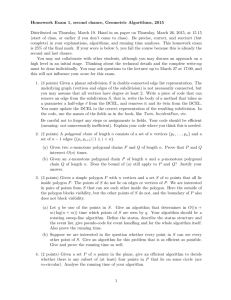The Area Bisectors of a Polygon and Force Equilibria in
advertisement
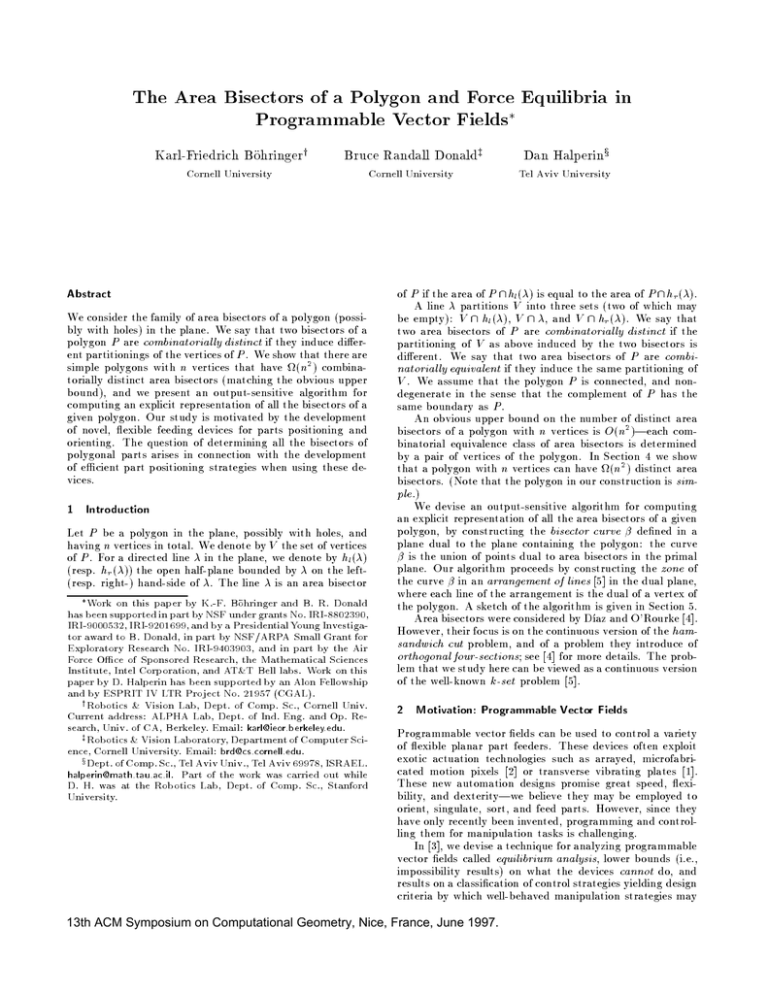
The Area Bisectors of a Polygon and Force Equilibria in
Programmable Vector Fields
y
Karl-Friedrich B
ohringer
Cornell University
z
Bruce Randall Donald
Abstract
We consider the family of area bisectors of a polygon (possibly with holes) in the plane. We say that two bisectors of a
polygon P are combinatorially distinct if they induce dierent partitionings of the vertices of P . We show that
there are
simple polygons with n vertices that have (n2 ) combinatorially distinct area bisectors (matching the obvious upper
bound), and we present an output-sensitive algorithm for
computing an explicit representation of all the bisectors of a
given polygon. Our study is motivated by the development
of novel, exible feeding devices for parts positioning and
orienting. The question of determining all the bisectors of
polygonal parts arises in connection with the development
of ecient part positioning strategies when using these devices.
Cornell University
1 Introduction
Let P be a polygon in the plane, possibly with holes, and
having n vertices in total. We denote by V the set of vertices
of P . For a directed line in the plane, we denote by hl ()
(resp. hr ()) the open half-plane bounded by on the left(resp. right-) hand-side of . The line is an area bisector
Work on this paper by K.-F. B
ohringer and B. R. Donald
has been supported in part by NSF under grants No. IRI-8802390,
IRI-9000532, IRI-9201699, and by a Presidential Young Investigator award to B. Donald, in part by NSF/ARPA Small Grant for
Exploratory Research No. IRI-9403903, and in part by the Air
Force Oce of Sponsored Research, the Mathematical Sciences
Institute, Intel Corporation, and AT&T Bell labs. Work on this
paper by D. Halperin has been supported by an Alon Fellowship
and by ESPRIT IV LTR Project No. 21957 (CGAL).
y Robotics & Vision Lab, Dept. of Comp. Sc., Cornell Univ.
Current address: ALPHA Lab, Dept. of Ind. Eng. and Op. Research, Univ. of CA, Berkeley. Email: karl@ieor.berkeley.edu.
z Robotics & Vision Laboratory, Department of Computer Science, Cornell University. Email: brd@cs.cornell.edu.
x Dept. of Comp. Sc., Tel Aviv Univ., Tel Aviv 69978, ISRAEL.
halperin@math.tau.ac.il. Part of the work was carried out while
D. H. was at the Robotics Lab, Dept. of Comp. Sc., Stanford
University.
x
Dan Halperin
Tel Aviv University
of P if the area of P \ hl () is equal to the area of P \ hr ().
A line partitions V into three sets (two of which may
be empty): V \ hl (), V \ , and V \ hr (). We say that
two area bisectors of P are combinatorially distinct if the
partitioning of V as above induced by the two bisectors is
dierent. We say that two area bisectors of P are combinatorially equivalent if they induce the same partitioning of
V . We assume that the polygon P is connected, and nondegenerate in the sense that the complement of P has the
same boundary as P .
An obvious upper bound on the number of distinct area
bisectors of a polygon with n vertices is O(n2 )|each combinatorial equivalence class of area bisectors is determined
by a pair of vertices of the polygon. In Section
4 we show
that a polygon with n vertices can have (n2 ) distinct area
bisectors. (Note that the polygon in our construction is simple.)
We devise an output-sensitive algorithm for computing
an explicit representation of all the area bisectors of a given
polygon, by constructing the bisector curve dened in a
plane dual to the plane containing the polygon: the curve
is the union of points dual to area bisectors in the primal
plane. Our algorithm proceeds by constructing the zone of
the curve in an arrangement of lines [5] in the dual plane,
where each line of the arrangement is the dual of a vertex of
the polygon. A sketch of the algorithm is given in Section 5.
Area bisectors were considered by Daz and O'Rourke [4].
However, their focus is on the continuous version of the hamsandwich cut problem, and of a problem they introduce of
orthogonal four-sections; see [4] for more details. The problem that we study here can be viewed as a continuous version
of the well-known k-set problem [5].
2 Motivation: Programmable Vector Fields
Programmable vector elds can be used to control a variety
of exible planar part feeders. These devices often exploit
exotic actuation technologies such as arrayed, microfabricated motion pixels [2] or transverse vibrating plates [1].
These new automation designs promise great speed, exibility, and dexterity|we believe they may be employed to
orient, singulate, sort, and feed parts. However, since they
have only recently been invented, programming and controlling them for manipulation tasks is challenging.
In [3], we devise a technique for analyzing programmable
vector elds called equilibrium analysis, lower bounds (i.e.,
impossibility results) on what the devices cannot do, and
results on a classication of control strategies yielding design
criteria by which well-behaved manipulation strategies may
13th ACM Symposium on Computational Geometry, Nice, France, June 1997.
be developed. Equilibrium analysis is a fundamentally
geometric problem. To illustrate, let us make the following
assumptions. Suppose that (1) Each motion pixel is very
small relative to the part we wish to manipulate, and hence
a dense array of pixels may be modeled as a 2-dimensional
vector eld. (2) The part to be manipulated is essentially
laminar. (3) The part is connected.
A squeeze eld is dened by making all the actuators
push normally towards a common squeeze line. In [3], we
show that under certain dynamic and mechanical assumptions, we can compute a sequence of squeeze elds guaranteed to bring any part into unique moment equilibrium. No
sensing is required, but a clock is required to switch between
elds.
In order to be in equilibrium, the forces and moments
must balance. Force equilibrium, under our assumptions, is
equivalent to: the squeeze line must be an area bisector of the
polygon. The number of equilibria critically impacts both
the complexity of plan generation, and plan size. Therefore,
it is important to bound the number of equilibria for a given
part or class of parts. In [3] we show that every convex part
has at most O(n) equilibria, and every non-convex part has
O(rn2 ) equilibria (r is the maximum number of edges of P
intersected by any line), under squeeze elds.
In this paper, we show how to analyze the number of
area bisectors, and hence bound the number of force equilibria. Our algorithm for computing area bisectors can be
used as a preliminary step in designing alignment plans (see
Section 6).
3 Properties of Area Bisectors
In this section we state several properties of area bisectors
of polygons.
The proofs can be found in the full version of
the paper.1
Lemma 3.1 Let P be a non-degenerate
polygon with n vertices. (1) There exist O(n2 ) combinatorially distinct ways in
which a line can partition P . (2) Let A and B be the intersections of an area bisector with the boundary of the convex
hull of P . As the slope of varies from ,1 to +1, A and
B progress monotonically counterclockwise on the boundary
of the convex hull of P . (3) For every slope x there exists a
unique bisector of P with slope x.
Lemma 3.2
Let P be a polygon with n vertices. Let s be a
2
point in R and let be a line that intersects r edges of P .
The area bisectors of P that are combinatorially equivalent
to and pass through s are determined by the roots of a
polynomial equation of degree r.
In the full version of the paper we show that the bisectors
of a polygon P can be described by a piece-wise algebraic
curve, where each piece is described by a polynomial whose
degree depends on the number of edges of P intersected by
the corresponding bisectors.
4 Lower Bound
As argued
above, a polygon with n vertices can have at most
O(n2 ) combinatorially distinct area bisectors. In this section
we give an example
of a simple polygon with n vertices where
the bound (n2 ) is attained.
Consider Figure 1. All the vertices vi ; vi0 ; ui and u0i lie on
a circle whose center is at c. The vertices wj lie very close
1 Forthcoming as a Technical Report, Computer Science Department, Cornell University.
v2
u2
v3
u3
u1
v1
v4
wj
c
v10
v40
u03
v30
u0
2
v20
u01
Figure 1: A simple polygon with n vertices that has (n2 )
combinatorially distinct bisectors.
to c on a small circle whose center is c as well, along two
convex polygonal chains.
We x an integer m (that we will determine later; for
the polygon in the gure m = 3). The distance between the
vertices vi and vi+1 is the same for
i = 1; : : : ; m, and it is the
same as the distance between vi0 and vi0+1 for i = 1; : : : ; m.
The area of all triangles viui vi+1 for i = 1; : : :0 ; m
is the
same and is equal to the area of all triangles viu0i vi0+1 for
i = 1; : : : ; m. There are 2m vertices wj near c and they
are equally spaced on a small circle centered at c. 0As can
be easily veried, for every pair of vertices vi and vi , there
is a bisector passing through these points that passes also
through the center point c. We next claim that as we rotate
the bisector from vi to vi+1 it will move o the center c and
sweep m vertices wj . The reason
is that the angle 6 ui vi vi+1
is larger than the angle 6 u0i vi0 vi0+1 . Hence, as the bisector
rotates, it will proceed `faster' on the bottom part of our
polygon than on the top part and therefore will sweep half
of the vertices wj on its way. Finally m is chosen such that
(roughly) n = 6m2 +8. The2 number of distinct area bisectors
is evidently (m ) = (n ).
5 Output-Sensitive Algorithm
It is convenient to study the algorithmic problem in a dual
plane: a line y = 2xx , y in the primal plane is transformed
into the point (x; y) in the dual plane. A point (x; y) in the
primal plane is transformed into the line y = 2xx , y in the
dual. The dual of an object o will
be denoted by o . If O is
a set of objects in the plane, O will denote the set of dual
objects.
Let P be a polygon with n vertices as dened in the Introduction, namely connected, non-degenerate and possibly
with holes. In the dual
plane every vertex v of P is transformed into a line v which is the collection of all points
dual to lines in the primal plane that pass through v.
For any given direction there is a unique area bisector.
We denote the oriented bisector of P that makes an angle with the positive x-axis by B (), and (because of symmetry)
conne ourselves to the range [,=2; =2) for . We denote
the collection of points dual to area bisectors of P in that
range by . Note that any (besides ,=2) corresponds to
an x-coordinate in the dual plane.
The curve is a piece-wise algebraic and x-monotone
curve (this is proved in the full version of the paper). We
13th ACM Symposium on Computational Geometry, Nice, France, June 1997.
exit point
`1
p1
f
p = (B (0 ))
(a)
`2
f
(b)
Figure 2: Ray shooting to determine the face f containing
p (a), and then nding the maximal pieces of inside f and
its exit points from f (b).
call the bisector curve of P , as it gives a complete specication of all the area bisectors of the polygon P . We denote
by the number of maximal connected algebraic pieces in
, where the function describing each piece is dened by
the xed set of edges that the corresponding set of bisectors
cross. In this section we describe an output-sensitive algorithm to compute . Since we aim for output-sensitivity,
we cannot aord to compute the
entire arrangement A(V )
whose complexity may be (n2 ). We will discover the maximal pieces of in their order along , using two primitive
operations: ray shooting among the lines V , and intersection of an algebraic curve with a straight line.
We choose an arbitrary direction 0 2 [,=2; =2) and
look for the area bisector of P in that direction. This requires O(n log n) time since the polygon may have holes.
Next, we obtain the set of edges crossed by B (0 ). We denote by E () the set of edges crossed by B (). The set
E (0 ) determines a function := (0 ) describing the bisector curve in a neighborhood of 0 , as long as the set
of edges crossed by the bisector does not change. In the
dual plane the function describes
the curve as long as
we do not leave
the
face
of
A
(
V
)
which
contains the point
p := (B (0 )) .
Our next step is to construct the face f that contains
the point p in A(V ). We describe this procedure assuming
f is bounded; the extension to unbounded faces is straightforward. We prepare in advance a data structure R (V )
that supports ecient ray shooting among the lines V . We
shoot a ray from p in the upward vertical direction and identify the line `1 2 V supporting the edge of f above p. See
Figure 2(a). We next proceed in clockwise direction along
the boundary
of f . From the point p1 2 `1 we shoot a ray
in A(V ) along `1 , and identify the line `2 supporting the
next edge on the boundary of f , and so on until we have
returned to `1 and thus have identied the entire face f .
Now we determine the maximal connected pieces of f \ .
For each edge on boundary of f we compute the intersection of its supporting line v with . This computation is
equivalent to nding the bisectors that pass through the vertex v, and intersecting the edges in E (0 ). By Lemma 3.2,
this reduces to solving a polynomial equation of degree r,
where r is the number of edges in E (0 ). We denote the
time required to nd these roots by (r).
We order the resulting intersections along the x-axis.
Since the curve is x-monotone, this ordered list of intersections provides a description of the curve inside f ,
and indicates what are the neighboring faces that crosses.
We mark each of these additional faces by the point where
crosses out of f . We call each such point an exit point.
See Figure 2(b).
Since f has already been constructed, we know for each
exit point of the line that contains it. Therefore we can
construct each new face using ray shooting queries and proceed as above. We keep a data structure that describes all
the faces of A(V ) that have already been constructed so
that we do not construct the same face twice.
The algorithm stops when we have identied all the intersection points of with lines in V , and so we have also
identied
the zone of in A(V ), namely all the face of
A(V ) crossed by .
Further details on the algorithm can be found in the full
version of the paper. We summarize the algorithmic result
in the following theorem.
Theorem 5.1 Let P be a non-degenerate polygon (possibly
with holes) with n vertices, and such that any line crosses
at most r edges of P . For any " > 0 we can nd a complete
specication of the area bisectors of P in time O(2=3 n2=3+" +
() (r)), where and (r) are as dened above, and ()
is the functional inverse of Ackermann's function. If P is
rectilinear, then the algorithms runs in time O(2=3 n2=3+" ).
The space required by the algorithm is O(2=3 n2=3+" ).
6 Moment Equilibria and Alignment Plans
As described in Section 2, bisectors correspond to force equilibria of P in a squeeze eld. For total equilibrium, the moment acting on the part has to be taken into account as well.
In particular, not all of the force equilibrium congurations
will be moment equilibria. For each maximal piece b of the
bisector curve there exists only a nite number of moment
equilibria (we omit the proof here):
Lemma 6.1 Let P be a polygon whose interior is connected.
Let be a bisector of P that intersects r edges of P . There
exist O(r) lines 0 that are combinatorially0 equivalent to such that P is in total equilibrium when coincides with
the center line of a squeeze eld.
It follows that a squeeze eld induces a nite number of
total equilibria on a polygonal part P . In [3] we show how
to exploit this niteness property to automatically generate
alignment plans that bring P into a unique (up to symmetry)
orientation, by cascading squeeze elds that systematically
reduce the possible orientations of P .
References
[1] K.-F. Bohringer, V. Bhatt, and K. Y. Goldberg. Sensorless
manipulation using transverse vibrations of a plate. In Proc.
IEEE Int. Conf. on Robotics and Automation (ICRA), pages
1989 { 1996, Nagoya, Japan, May 1995.
[2] K.-F. Bohringer, B. R. Donald, and N. C. MacDonald. Singlecrystal silicon actuator arrays for micro manipulation tasks. In
Proc. IEEE Workshop on Micro Electro Mechanical Systems
(MEMS), San Diego, CA, Feb. 1996.
[3] K.-F. Bohringer, B. R. Donald, and N. C. MacDonald. Upper
and lower bounds for programmable vector elds with applications to MEMS and vibratory plate parts feeders. In J.-P.
Laumond and M. Overmars, editors, Algorithms for Robotic
Motion and Manipulation. A. K. Peters, Wellesley, MA 02181,
1997.
[4] M. Daz and J. O'Rourke. Ham-sandwich sectioning of polygons. In Proc. 2nd Canadian Conference on Computational
Geometry, pages 98{101, Ottawa, 1990.
[5] H. Edelsbrunner. Algorithms in Combinatorial Geometry,
volume 10 of EATCS Monographs on Theoretical Computer
Science. Springer Verlag, Heidelberg, Germany, 1987.
13th ACM Symposium on Computational Geometry, Nice, France, June 1997.



